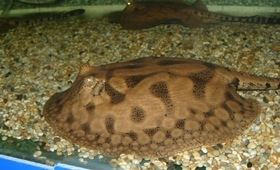Genus Potamotrygon Higher classification Potamotrygon | Phylum Chordata Scientific name Potamotrygon hystrix Rank Species | |
 | ||
Similar Potamotrygon, Batoids, Potamotrygonidae, Raspy river stingray, Stingray | ||
The porcupine river stingray, Potamotrygon histrix, is a species of river stingray in the family Potamotrygonidae, the type of the Potamotrygon genus. It is found in the basins of the Paraná and Paraguay River basins in South America.
Contents
Appearance
Almost circular in shape, it grows up to 40 cm (16 in) in diameter and 70 cm (28 in) in length, including the tail. The upper surface is covered with denticles (sharp tooth-like scales). The coloration is light brownish with mottled patterns on the dorso, and pink on the ventral side. As with all stingrays, the mouth and gill openings are on the underside, and the eyes and gills exits are on the dorsal side.
Sting
Like other stingrays, the fish of this genus have venomous barbs at the base of their tails, and are dangerous to humans. The sting is replaced at roughly six-month intervals. It is an almost flat, barbed structure that can reach 6 cm (2.4 in) in length, and is covered with a toxic mucus, making any attack a very painful one.
The natives of South America are said to fear the stingray more than the piranha. However, they are not aggressive fish and not dangerous unless stepped on or otherwise threatened.
Aquarium
Freshwater stingrays of the genus Potamotrygon are sometimes kept as exotic aquarium fish; though freshwater stingray of other genera do appear in the trade, most are from this genus. They are best kept with a deep, sandy substrate, in which they bury themselves, often with only their eyes visible. They are not territorial with other animals and can be kept in groups, provided a large enough aquarium is provided. They are carnivorous bottom-feeders and require strong filtration as they are rather sensitive to water conditions (any spike in NO2 levels can kill them with no warning).
Like many species of stingrays, P. histrix has been bred in captivity, but they require a large tank. The male should be smaller than the female, as it is rather aggressive, biting the female during the mating process. Males can be determined by the presence of claspers as in other chondrichthyans.
